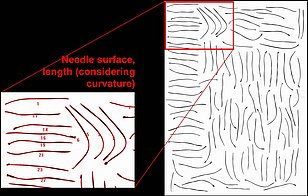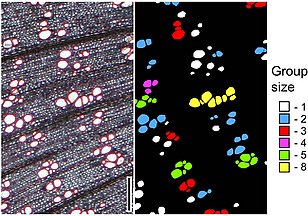ROXAS produces >120 parameters on the entire image, annual ring and individual cell level and saves them into MS Excel and text files. It also measures characteristics of conifer needles. Below is a non-exhaustive overview.
Output for the entire image:
- Area of analyzed tissue
- Number of annual rings
- Mean ring area
- Mean ring width
- Overall number of cells
- Mean number of cells per ring
- Accumulated cell lumen area
- Mean cell lumen area
- Mean radial cell lumen diameter
- Mean tangential lumen diameter
- Mean thickness of pith-ward cell walls
- Mean thickness of bark-ward cell walls
- Mean thickness of 'left' cell walls (viewed from pith to bark)
- Mean thickness of 'right' cell walls (viewed from pith to bark)
- Mean thickness of tangential cell walls
- Mean thickness of radial cell walls
- Mean cell wall thickness (average of tangential and radial walls)
- Mean hydraulic diameter (Dh)
- Cell density (no./mm2)
- Percentage of conductive area
- Total hydraulic conductivity (Kh) based on Poiseuille’s law
- Specific hydraulic conductivity (Ks) based on Poiseuille’s law
- Vessel grouping index (sensu Carlquist; see Fig. 1 below)
- Vessel solitary fraction
- Mean group size of grouped / non-solitary cells
- Mean Mork's index (thickness-to-span ratio in radial direction)
- Mean bending resistance index [(t/b)2] (see Fig. 3 below)
- Number of needles
- Mean, minimum and maximum conifer needle surface
- Mean, minimum and maximum conifer needle length (considering curvatures! See Fig. 4 below)
- Mean, minimum and maximum conifer needle width
Output for each ring:
- Calendar year of each ring
- Ring area
- Ring width
- Number of cells
- Accumulated cell lumen area
- Mean cell lumen area
- Mean radial cell lumen diameter
- Mean tangential lumen diameter
- Mean thickness of pith-ward cell walls
- Mean thickness of bark-ward cell walls
- Mean thickness of 'left' cell walls (viewed from pith to bark)
- Mean thickness of 'right' cell walls (viewed from pith to bark)
- Mean thickness of tangential cell walls
- Mean thickness of radial cell walls
- Mean cell wall thickness (average of tangential and radial walls)
- Mean hydraulic diameter (Dh)
- Cell density (no./mm2)
- Percentage of conductive area
- Total hydraulic conductivity (Kh) based on Poiseuille’s law
- Specific hydraulic conductivity (Ks) based on Poiseuille’s law
- Vessel grouping index (sensu Carlquist; see Fig. 1 below)
- Vessel solitary fraction
- Mean group size of grouped / non-solitary cells
- Mean Mork's index (thickness-to-span ratio in radial direction)
- Mean bending resistance index [(t/b)2] (see Fig. 3 below)
Output for each cell or conifer needle:
- Assignment to ring
- Absolute radial position in the ring (distance from ring border)
- Relative position in the ring (from 0 to 100%)
- Number of touching vessels (belonging to the same grouping; see Fig. 1 below)
- Aspect ratio (ratio of minor to major axis)
- Angle of major axis
- Thickness of pith-ward cell wall
- Thickness of bark-ward cell wall
- Thickness of 'left' cell wall (viewed from pith to bark)
- Thickness of 'right' cell wall (viewed from pith to bark)
- Thickness of tangential cell walls
- Thickness of radial cell walls
- Mean cell wall thickness (average of tangential and radial walls)
- Hydraulic conductivity (Kh) based on Poiseuille’s law
- Mork's index (thickness-to-span ratio in radial direction)
- Bending resistance index [(t/b)2] (see Fig. 3 below)
- Conifer needle surface
- Conifer needle length (considering curvatures! See Fig. 4 below)
- Conifer needle width



